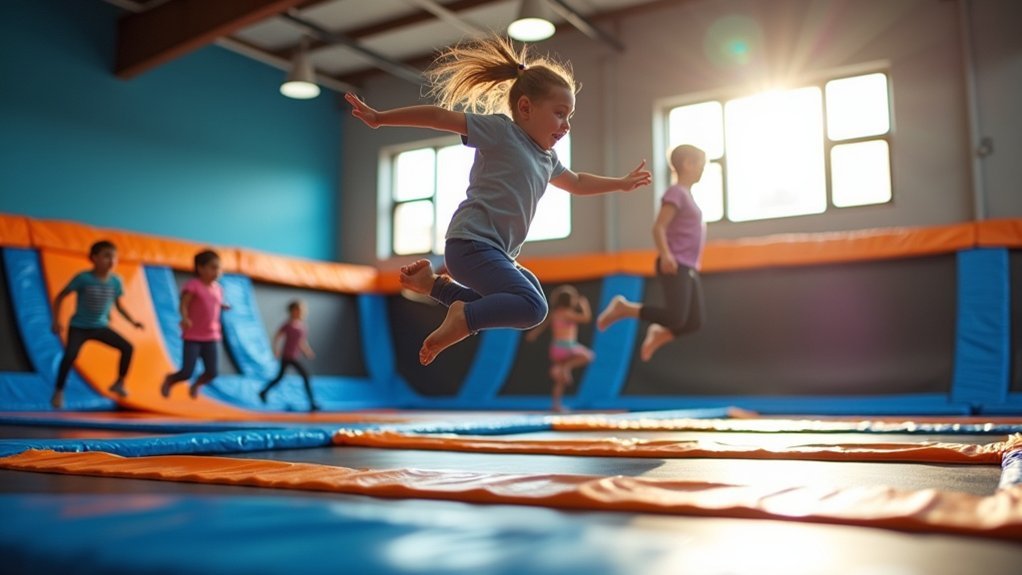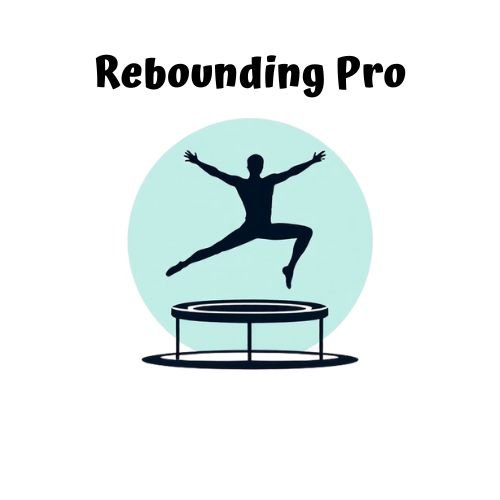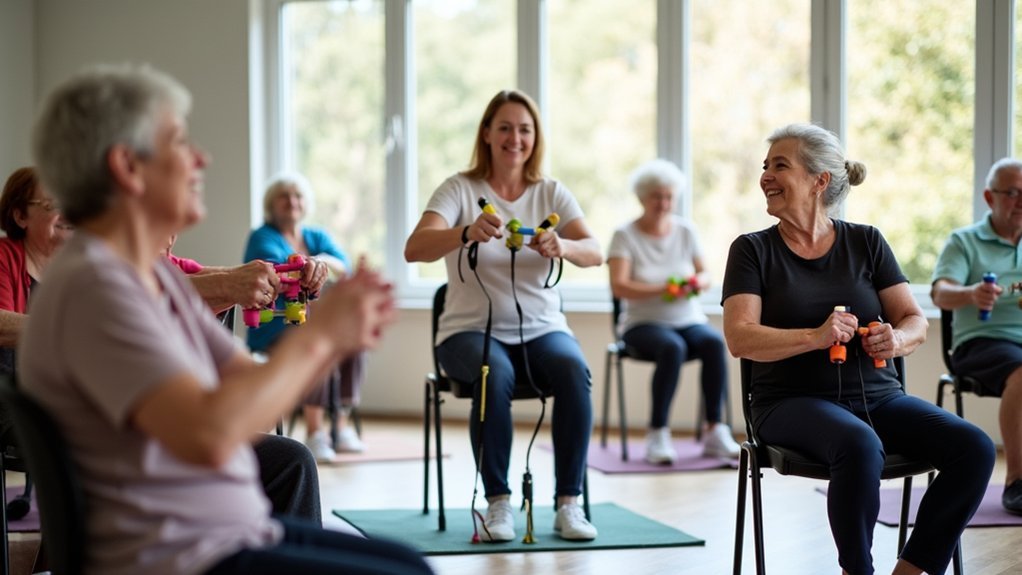Most experts recommend children wait until age 6 to begin trampoline fitness with proper supervision. Before this age, children’s developing bones and limited motor control increase injury risks substantially. For 6-10 year-olds, start with small to medium trampolines (6-12 ft) and always enforce the “one jumper at a time” rule. You’ll need to provide constant adult supervision until at least age 12. Learn what physical milestones indicate your child is truly ready for safe rebounding.
Trampoline Fitness: Appropriate Starting Ages

While many parents wonder when their children can safely begin trampoline fitness, age-appropriate guidelines help guarantee both fun and safety.
Children as young as 3-4 years can participate in supervised trampoline activities on specially designed equipment that prioritizes trampoline safety.
However, the American Academy of Pediatrics advises against backyard trampoline use for children under six due to their undeveloped bones and higher injury risks.
Children under six shouldn’t use backyard trampolines as their developing skeletal structure increases injury susceptibility.
For 6-10 year olds, small to medium trampolines (6-12 ft) provide an ideal environment to develop coordination safely.
Once your child reaches the preteen and teenage years (11-17), larger trampolines (12-16 ft) better accommodate their growing strength and agility.
Remember that regardless of age, adult supervision remains essential for all trampoline activities to prevent injuries.
Physical Developmental Milestones for Safe Rebounding
Your child’s physical development directly impacts when they’re ready for trampoline use, with age six typically marking sufficient balance and coordination for supervised rebounding.
You’ll want to evaluate your child’s bone density, as proper skeletal development is essential to withstand the repetitive impact of jumping.
Monitoring these developmental milestones helps you determine the right time to introduce trampoline fitness while minimizing injury risks.
Physical Developmental Milestones for Safe Rebounding
Safety considerations must guide the introduction of children to trampoline activities, with age six marking an important developmental threshold. By this age, your child’s coordination, strength, and balance have typically developed enough to handle the physical demands of rebounding safely.
Around six years, children reach key milestones that make trampoline fitness appropriate. This age is best because most kids have developed sufficient impulse control to follow important safety rules like the “One-Jumper at a Time” guideline. Their bones are also more resilient compared to younger children.
Even with these developments, never leave children under 12 unsupervised on a trampoline. Their growing bodies still need protection, and your guidance guarantees they learn proper jumping techniques while enjoying this physical activity safely.
Balance and Coordination Readiness
Understanding balance and coordination readiness helps parents recognize when their child can safely enjoy trampoline activities.
Most children develop the necessary balance and coordination skills for safe trampoline use around age six, when their motor skills and impulse control greatly improve.
Before this age, children’s undeveloped bones and limited balance put them at higher risk for injuries—nearly half of all trampoline-related injuries occur in children under six.
Your child needs advanced coordination and spatial awareness to jump safely, abilities that typically develop between ages five and seven.
Once your child reaches six to twelve years old, supervised trampoline use can actually enhance their developing balance and coordination skills.
Bone Density Considerations
Developing adequate bone density represents a critical milestone before children can safely engage in trampoline activities.
Children under six years old have underdeveloped skeletal structures that aren’t ready for the impact forces trampolining creates. This explains why nearly half (48.3%) of all trampoline injuries occur in this vulnerable age group.
The American Academy of Pediatrics strongly advises against children under six using backyard trampolines without supervision due to their heightened fracture risk.
If you’re considering trampoline fitness for your young child, look for age-appropriate options with lower frames and enhanced safety features.
For children ages three to six, specialized trampolines can actually support healthy bone development when used properly.
Remember that your child’s coordination, balance, and bone density must all reach appropriate levels before they’re ready for regular trampoline use.
Toddlers and Trampolines: When Is It Too Early?
When considering trampolines for toddlers under six, you’ll need to weigh significant developmental concerns against the American Academy of Pediatrics’ clear recommendation against their use due to undeveloped bones and limited motor skills.
Your toddler’s safety requires a careful risk assessment, as children this age account for nearly half of all serious trampoline-related injuries including fractures and head trauma.
If you’re still interested in bouncing activities, supervised alternatives like specialized mini trampolines with safety features provide a better option until your child reaches appropriate developmental milestones.
Toddler Development Concerns
Although trampolines might seem like fun play equipment for children of all ages, they pose serious risks for toddlers under six years old. The American Academy of Pediatrics strongly advises against trampoline use for this age group due to their underdeveloped bones and motor skills.
Nearly half of all trampoline injuries affect children under six, with fractures accounting for 35.9% of these incidents. Your toddler’s developing body simply isn’t ready for the impact and coordination trampolines require.
- Your child’s bones are still forming and more susceptible to serious damage.
- Their balance and motor control aren’t developed enough for safe bouncing.
- They lack the impulse control to follow safety rules consistently.
- Their smaller size puts them at greater risk when jumping with others.
Safety Risk Assessment
Many parents ask, “At what age is trampoline use actually safe?” The answer is clear and backed by medical experts: children under six face considerably higher risks that outweigh any potential benefits.
Almost half of all trampoline injuries (48.3%) occur in children under six years old, with their developing bones and limited motor skills making them particularly vulnerable.
| Age Group | Safety Concern | Injury Rate | Recommendation |
|---|---|---|---|
| Under 6 | Undeveloped bones | 48.3% of all injuries | Avoid completely |
| Under 6 | Limited motor skills | High fracture risk (35.9%) | Use alternatives |
| Toddlers | Poor impulse control | Higher head injury risk | Try tumbling mats |
| All young children | Lack of coordination | Elevated accident rate | Supervised activities |
Instead of trampolines, consider safer alternatives like tumbling mats or play tunnels that still promote physical development without the injury risks.
Supervised Alternatives Available
Despite the clear safety guidelines against full-size trampolines for children under six, parents seeking physical activity options for their energetic toddlers aren’t completely out of luck.
Several supervised alternatives available can provide similar benefits while minimizing risks.
- Mini trampolines designed specifically for ages 3-5 offer bounce time with enhanced safety features.
- Indoor trampolines with surrounding nets create controlled environments where you can closely monitor your child’s activity.
- Tumbling mats and tunnels develop the same motor skills without the height risks of traditional trampolines.
- Plum Play and similar brands offer toddler-specific designs that align with ASTM safety standards.
These alternatives allow your young children to burn energy and develop coordination while you maintain peace of mind.
Remember that supervision remains essential regardless of which equipment you choose for your under-six bouncer.
Age-Specific Safety Guidelines for Young Jumpers
When considering trampoline fitness for children, understanding age-appropriate safety guidelines becomes crucial for preventing injuries. The age restrictions established by experts aren’t arbitrary—they’re based on developmental readiness and injury statistics.
Children under six should avoid trampolines completely due to their undeveloped bones and limited motor skills. Once your child reaches six, you can introduce trampoline activities with proper supervision.
| Age Group | Recommended Trampoline Size | Supervision Level |
|---|---|---|
| Under 6 | Not recommended | N/A |
| 6-10 | 6ft-12ft diameter | Constant |
| 11-17 | Standard size | Regular |
Remember that nearly half of trampoline injuries affect children under six. Even with older children, always confirm safety features like netting and padding are intact, as these greatly reduce injury risks for enthusiastic young jumpers.
Supervision Requirements Across Different Age Groups

Effective supervision serves as the cornerstone of trampoline safety for children, with requirements varying considerably based on developmental stages.
Proper supervision isn’t optional—it’s the foundation of trampoline safety, adapting to each child’s developmental needs.
For children under six, the supervision requirement is simple: they shouldn’t be on trampolines at all, as recommended by the American Academy of Pediatrics.
- Be vigilant with children 6-17, who need constant adult supervision—remember, they represent 92% of trampoline fractures.
- Enforce the vital “One-Jumper at a Time” rule to prevent the dangerous collisions that frequently cause injuries.
- Never leave children unsupervised, even for a moment—serious injuries can happen in seconds.
- Stay close enough to intervene when unsafe behaviors like flips or roughhousing begin.
These supervision requirements aren’t suggestions—they’re essential safeguards against the very real dangers trampolines pose to developing bodies.
Mini-Trampolines vs. Full-Size Options for Children
Size matters considerably when selecting trampolines for children, with mini and full-size options serving distinctly different age groups and developmental needs.
Mini-trampolines are ideal for children as young as three, offering a safer environment with lower frames and smaller diameters that reduce fall distance while still promoting motor skill development.
In contrast, full-size trampolines, which typically range from 6 to 16 feet in diameter, are appropriate only for children six years and older. Your younger child’s developing bones and limited motor control make them more susceptible to injuries on larger equipment.
When you’re ready to shift to full-size trampolines, remember they require consistent adult supervision and strict adherence to safety guidelines for children up to 17 years old.
Matching the trampoline size to your child’s age guarantees both safety and enjoyment.
Building Core Strength Through Age-Appropriate Rebounding

Trampoline rebounding offers children a uniquely effective method to develop essential core strength while they’re having fun.
Children as young as 3 can start trampoline fitness with proper supervision, focusing on exercises that match their developmental stage. These controlled bouncing activities strengthen the abdominal and back muscles vital for stability and balance.
- Watch your child’s confidence soar as they master new rebounding skills
- Feel pride as their improved coordination translates to better performance in other activities
- Experience joy in their laughter while they’re building strength without realizing it
- Marvel at their growing independence as core strength supports their physical development
Balance and Coordination Benefits for Growing Bodies
A well-developed sense of balance serves as the foundation for virtually all physical activities your child will engage in throughout life.
Trampolines for kids provide an exceptional platform to develop these essential skills. When your child jumps, they’re constantly adjusting their body position mid-air, greatly enhancing their proprioception and spatial awareness.
The rhythmic bouncing motion challenges children to time their movements precisely, improving coordination that transfers to other sports and activities. For children 6 and older, regular trampoline sessions help develop the motor skills necessary for athletic performance.
The stabilization required during bouncing strengthens core muscles, which directly supports better balance in daily activities.
You’ll notice improved coordination as your child’s body learns to maintain control through each bounce and landing.
Protective Gear Recommendations by Age
While developing coordination is important, ensuring your child’s safety with proper protective equipment is equally valuable.
Safety and skill development go hand-in-hand—proper protective gear is as crucial as coordination training for young jumpers.
Protective gear recommendations by age can considerably reduce injury risks while still allowing kids to enjoy trampoline fitness benefits.
- For toddlers and preschoolers (3-5 years), helmets and knee pads are essential—their developing bodies need maximum protection on age-appropriate trampolines.
- Elementary-aged children (6-12) should use padded socks and wrist guards as they develop better coordination but still need protection during enthusiastic jumping.
- Teens (13-17) benefit from ankle supports and padded clothing when attempting more advanced techniques.
- Adults should choose supportive trampoline-specific footwear for proper traction during fitness classes.
Remember that regardless of age, protective gear should always be worn during trampoline activities, especially for high-impact movements that increase injury risk.
Signs Your Child Is Ready for Trampoline Exercise
How can you determine if your child is prepared to safely enjoy trampoline fitness? Look for clear signs of readiness in both physical and behavioral development.
Children as young as 3 can start on specially designed trampolines, but you’ll want to observe their specific capabilities.
Watch for your child’s ability to follow safety instructions consistently—this is vital for preventing injuries. Their excitement about jumping and physical activity often indicates natural interest.
By age 6, most children develop improved coordination and balance, making trampoline exercises more accessible.
Assess your child’s strength and agility during everyday activities. Can they maintain balance? Do they demonstrate body awareness?
These physical indicators help guarantee they’re ready for the demands of trampoline fitness, which can help combat childhood obesity while building healthy habits.
Structured Rebounding Activities for Different Age Groups
Once you’ve determined your child is ready for trampoline fitness, selecting age-appropriate activities becomes the next step.
Structured rebounding activities vary considerably across age ranges, ensuring safety and developmental appropriateness.
For young children (3-5), focus on supervised, low-impact exercises that build coordination rather than traditional jumping.
Children six and older can participate in regular classes, while preteens (11-12) can tackle more advanced strength and agility training.
- Teens thrive on social trampoline fitness that combines cardiovascular benefits with peer interaction
- Adults of all fitness levels find low-impact rebounding options that protect joints
- Preteens develop confidence through progressive skill-building activities
- Young children enjoy playful balance exercises that lay foundations for future fitness
Pediatrician Recommendations on Trampoline Fitness
Although trampolines provide exciting exercise opportunities, pediatricians maintain clear guidelines about their use with children. The American Academy of Pediatrics advises against trampoline use for any child under six years old, as their developing bones face higher injury risks.
For the six and older age group, trampoline fitness can be appropriate when implemented with strict safety measures. Always guarantee adult supervision and enforce the critical “One-Jumper at a Time” rule to prevent collisions.
Remember that children between 5-18 years account for 92% of trampoline-related fractures, highlighting why these recommendations matter.
If you’re incorporating trampolines into your child’s fitness routine, install proper safety features like secure netting and adequate padding to minimize potential injuries while allowing them to enjoy the benefits.
Preventing Growth Plate Injuries During Childhood Rebounding
To protect your child’s growth plates during trampoline activities, you’ll need to guarantee they maintain proper form with knees slightly bent when landing to absorb impact forces.
Teach them to land in the center of the trampoline with both feet simultaneously, avoiding awkward positions that could stress developing bones.
You must supervise all trampoline sessions regardless of your child’s age or skill level, as even experienced young jumpers can make dangerous errors when bouncing unsupervised.
Growth Plate Protection Basics
While trampolines provide exciting fitness opportunities for children, parents must understand how to protect their child’s developing growth plates during rebounding activities.
The American Academy of Pediatrics strongly advises against trampoline use for children under six, as their growth plates are particularly vulnerable to injury.
To safeguard your child’s developing bones:
- Wait until they’re at least six years old before introducing trampoline fitness, respecting their body’s developmental timeline.
- Allow only one jumper at a time to prevent collision injuries that commonly damage growth plates.
- Choose age-appropriate trampolines with lower bounce heights specifically designed for younger bodies.
- Guarantee constant adult supervision and teach proper jumping techniques to minimize landing impact.
These growth plate protection basics can help your child enjoy the benefits of rebounding while preserving healthy bone development.
Proper Landing Techniques
Learning proper landing techniques forms the cornerstone of safe trampoline use for children with developing bodies. Teach your child to land with bent knees, absorbing impact through their legs to protect vulnerable growth plates.
Ensure they position their feet shoulder-width apart and aim for centered landings on the trampoline surface. This balanced stance prevents falls and reduces stress on developing bones.
Emphasize soft, controlled landings rather than stiff-legged impacts that can hyperextend joints and damage growth plates. The risk of injury considerably increases with excessive bouncing and advanced moves like flips before basic landing skills are mastered.
Consider supervision from trained instructors who can reinforce these proper landing techniques until they become second nature.
With consistent practice, your child will develop habits that protect their growing bodies while enjoying trampoline fitness safely.
Supervision Remains Essential
Although trampoline activities can be engaging for children, supervision remains the single most critical factor in preventing growth plate injuries during rebounding sessions.
Children under six face higher risks due to their developing bones, while those aged six to seventeen still need your watchful eye to enforce safety guidelines.
Research confirms that proper supervision dramatically reduces serious injuries, particularly fractures that can damage growth plates.
Always guarantee:
- Only one child jumps at a time to prevent dangerous collisions
- An adult is present and actively monitoring all jumping activities
- Clear safety rules are established and consistently enforced
- Extra caution is taken with children under six, whose bones are especially vulnerable
Your supervision isn’t optional—it’s the difference between safe fun and potentially growth-altering injuries.
Frequently Asked Questions
Is It Okay for My 2 Year Old to Jump on a Trampoline?
No, it’s not okay for your 2-year-old to jump on a regular trampoline. Their bones are still developing, and they lack motor skills. Consider safer alternatives like mini trampolines with handrails or age-appropriate physical activities instead.
Can I Take My 2 Year Old to a Trampoline Park?
Taking your 2-year-old to a trampoline park isn’t recommended. Their bones aren’t fully developed, increasing injury risk. Most parks have age restrictions (typically 6+). Consider safer alternatives like soft play areas for toddlers instead.
What Age Should You Start Trampolining?
You shouldn’t let children under six use regular trampolines due to injury risk. However, toddler-specific trampolines can be used from age three with supervision. Always follow age recommendations for the specific trampoline type you’re using.
Is a Trampoline Good for a 3 Year Old?
Yes, a trampoline can be good for your 3-year-old if it’s specifically designed for toddlers with proper safety features like nets and shorter springs. Always supervise them while they’re bouncing to develop their motor skills safely.
In Summary
You’ll need to balance safety with your child’s development when introducing trampoline fitness. While most experts recommend waiting until age 6 for formal programs, your 3-5 year old can enjoy supervised, modified activities. Always follow age-appropriate guidelines, guarantee proper supervision, and watch for readiness signs. Remember, your child’s physical development and coordination matter more than their actual age when determining trampoline readiness.





Leave a Reply